 |
JAVA: JSP Action Elements and Scope |
| << Java Server Pages 3 |
| JAVA: JSP Custom Tags >> |
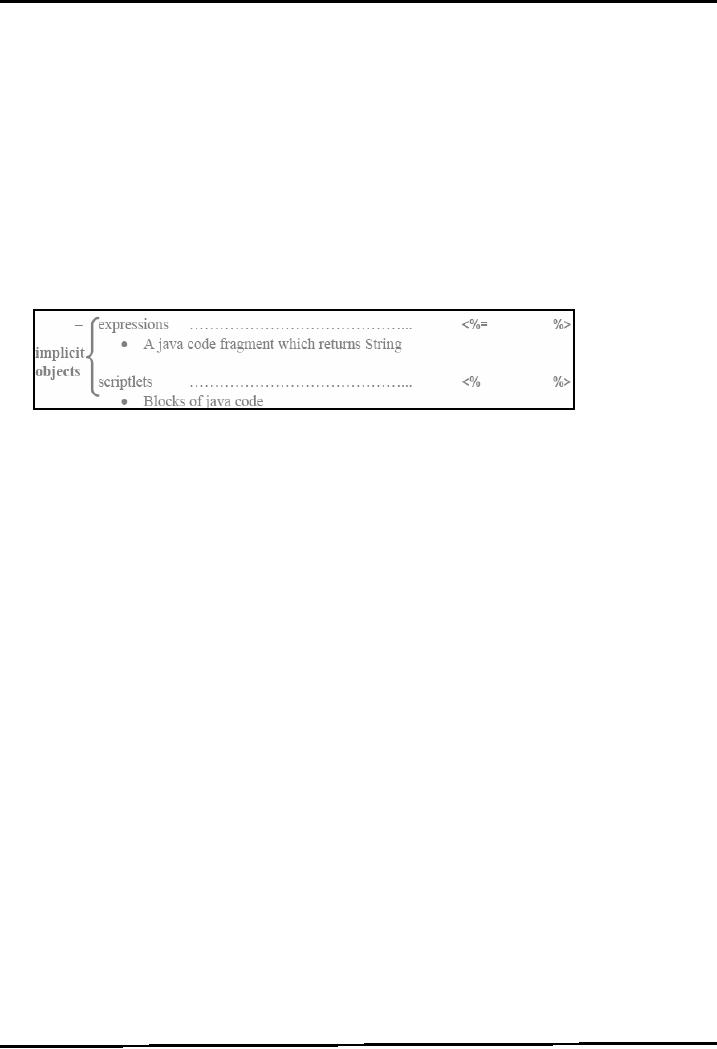
Web
Design & Development CS506
VU
Lesson
37
JSP
Action Elements and
Scope
The
journey we had started of JSP is
very much covered except of JSP
action elements. In this
handout,
we'll
study the use of JSP action
elements. Further also learn
how and where to store
JavaBean objects
that
can be shared among JSP
pages.
Let's
first quickly look on the
JSP journey to find out
where we have reached.
Directive
Elements
Provides global control of
JSP ......................... <%@
%>
Scripting
Elements
JSP comments
............................................. <%----%>
declarations
............................................. <%!
%>
Used to declare
instance variables &
methods
Action
Elements
Special
JSP tags ...........................................
<jsp:
..... />
JSP
Action Elements
JSP
action elements allow us to
work with JavaBeans, to
include pages at request
time and to forward
requests
to other resources
etc.
Format
Expressed
using XML syntax
-Opening tag
<jsp:actionElement attribute="value"
..... >
-Body
body
-Closing
tag </jsp:actionElement>
Empty
tags (without body) can
also be used like
<jsp:actionElement
attribute="value" ..... >
Some
JSP Action
Elements
To
work with JavaBeans
-<jsp:useBean
/>
-<jsp:setProperty
/>
-<jsp:getProperty
/>
To
include resources at request
time
-<jsp:include
/>
To
forward request to another JSP or
Servlet
-<jsp:forward
/>
To
work with applets
-<jsp:plugin
/>
Working
with JavaBeans using JSP
Action Elements
The
three action elements are
used to work with JavaBeans.
These are discussed in
detail below.
JSP
useBean Action
Element
274

Web
Design & Development CS506
VU
It is
used to obtain a reference to an existing
JavaBean object by specifying
id(name of object) and scope
in
which
bean is stored. If a reference is not
found, the bean is
instantiated.
The
format of this action element
is:
<jsp:useBean id
= "name" scope = "page|request|session|application"
class="package.Class
" />
The
id attribute specifies the name of the
JavaBean object that is also
used for later references.
The scope
attribute
can have one possible value out of
page, request, session and
application. If this attribute
is
omitted,
the default value of scope
attribute is page. We'll
discuss in detail about
scope shortly.
The
class attribute specifies the type of
object is going to be
created.
jsp:useBean
is being equivalent to building an
object in scriptlet. For
example to build an object
of
MyBeanusing
scriptlet is:
<%
MyBean m = new MyBean(
);%>
Achieving
above functionality using jsp:useBean
action element will look
like this:
<jsp:useBean id
= "m" scope = "page" class="vu.MyBean"
/>
In the above
code snippet, we are
assuming that MyBean lies in
vu package.
JSP
setProperty Action Element
To
set or change the property
value of the specified bean.
String values are converted to types of
properties
by
using the related conversion
methods.
The
format of this action element
is:
<jsp:setProperty
name = "beanName or id"
property = "name"value ="value"
/>
The
name attribute should match
the id given in jsp:useBean. The
propertyattribute specifies the name
of
the
property to change and the value
attribute specifies the new
value.
jsp:setProperty is
being equivalent to following
code of scriptlet. For
example to change the name
property
of m (instance of
MyBean) using scriptlet
is:
<%
m.setProperty("ali");
%>
Achieving
above functionality using jsp:setProperty
action element will look
like this:
<jsp:setProperty
name = "m" property = "name"
value = "ali" />
JSP
getProperty Action Element
Use
to retrieves the value of property, converts it to
String and writes it to output
stream. The format of
this
action element is:
<jsp:getProperty
name = "beanName or id"
property = "name" />
jsp:getProperty
is being equivalent to following
code of scriptlet. For
example to retrieve the name
property
of m (instance of
MyBean) followed by writing it to
output stream, scriptlet
code will look
like:
<%
String
name = m.getName( );
out.println(name);
%>
Achieving
above functionality using jsp:getProperty
action element will look
like this:
<jsp:getProperty
name = "m" property = "name"
/>
Example
Code: Calculating sum of two numbers by
using action elements and
JavaBean
This
example contains index.jsp and result.jsp
and one JavaBean i.e.
SumBean. User will enter
two
numbers
on index.jsp and their sum
will be displayed on result.jsp.
Let's examine these one
after another
SumBean.java
The
SumBean has following
attributes
firstNumber
275

Web
Design & Development CS506
VU
secondNumber
sum
The
firstNumber and secondNumbers
are "write-only" properties
means for these only
setters would be
defined.
Whereas sum is a "read-only"
property as only getter
would be defined for
it.
The
SumBean also contain one
additional method for calculating
sum i.e. calulateSum().
After performing
addition
of firstNumber with secondNumber, this
method will assign the result to
sum attribute.
package
vu;
import
java.io.*;
public
class SumBean implements
Serializable{
private
int firstNumber;
private
int secondNumber;
private
int sum;
// no argument
constructor
public
SumBean() {
firstNumber
= 0;
secondNumber =
0;
sum =
0;
}
//
firstNumber & secondNumber are
writeonly properties// setterspublic void
setFirstNumber(int n){
firstNumber
= n;
}
public
void setSecondNumber(int n){
secondNumber
= n;
}
// no
setter for sum
//
sum is a read only
property
public
int getSum( ){
return
sum;
}
//
method to calculate
sum
public
void calculateSum() {
sum =
firstNumber + secondNumber;
}
}
index.jsp
This
page will display two
text fields to enter number into
them.
<html>
<body>
<h2>Enter
two numbers to calculate their
sum</h2>
<form
name="myForm"
action="result.jsp">
<h3>
Enter first numebr <input
type="text" name="num1"
/><br/>
Enter
second numebr
<input
type="text" name="num2" />
<br/>
276

Web
Design & Development CS506
VU
<input
type="submit" value="Calculate Sum"
/>
</h3>
</form>
</body>
</html>
result.jsp
This
page will calculate the sum of
two entered numbers by the user
and displays the sum back to
user. The
addition
is performed using
SumBean
<%--
importing vu package that contains the
SumBean --
%><%@page
import="vu.*"%> <html>
<body>
<h2>The
sum is: <%--
instantiating bean using
action
element --
%>
//Servlet
equivalent code of
useBean
SumBean
sBean = new SumBean();
--%>
<jsp:useBean
id="sBean" class="vu.SumBean"
scope="page"/>
<%--
setting firstNumber property of
sBean
using
action elements
--
%>
<%--
implicit conversion from
string to int as num1 is of
typeString and
firstNumber
is of type int--%>
<%--//Servlet
equivalent code of setProperty for
num1int no =
Integer.parseInt(request.getParameter("num1"));sBean.setFirstNumber(no);
--%>
<jsp:setProperty
name="sBean"property="firstNumber" param="num1"
/>
<%--//Servlet
equivalent code of setProperty for
num2int no =
Integer.parseInt(request.getParameter("num2"));sBean.setSecondNumber(no);
--%>
<jsp:setProperty
name="sBean"property="secondNumber" param="num2"
/>
<%
//
calling calculateSum() method that will
set the value of// sum
attribute
sBean.calculateSum();
%>
<%--//
servlet equivalent code of
displaying sumint res =
sBean.getSum();out.println(res);
--%>
<jsp:getProperty
name="sBean" property="sum"
/>
</h2>
</body>
</html>
Sharing
Beans & Object
Scopes
So
far, we have learned the following techniques to
create objects.
-Implicitly
through JSP
directives
-Explicitly
through actions
-Directly
using scripting code
Although
the beans are indeed bound
to local variables, that is
not the only behavior. They
are also stored
in
four different locations,
depending on the value of the optional
scope attribute of jsp:useBean.
The scope
277
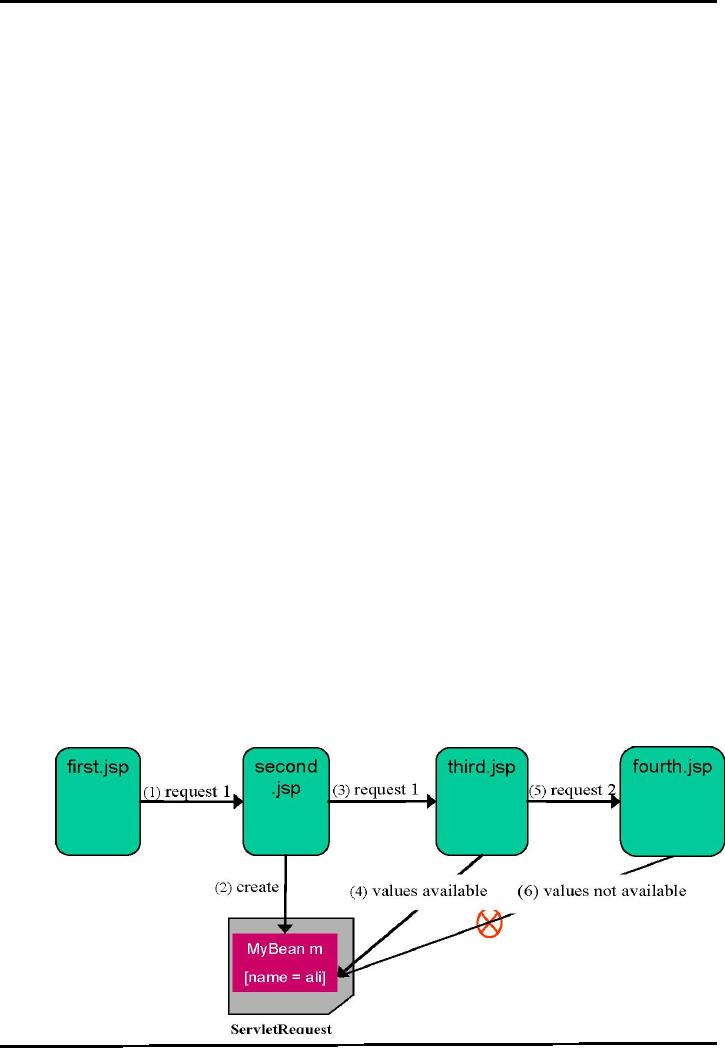
Web
Design & Development CS506
VU
278
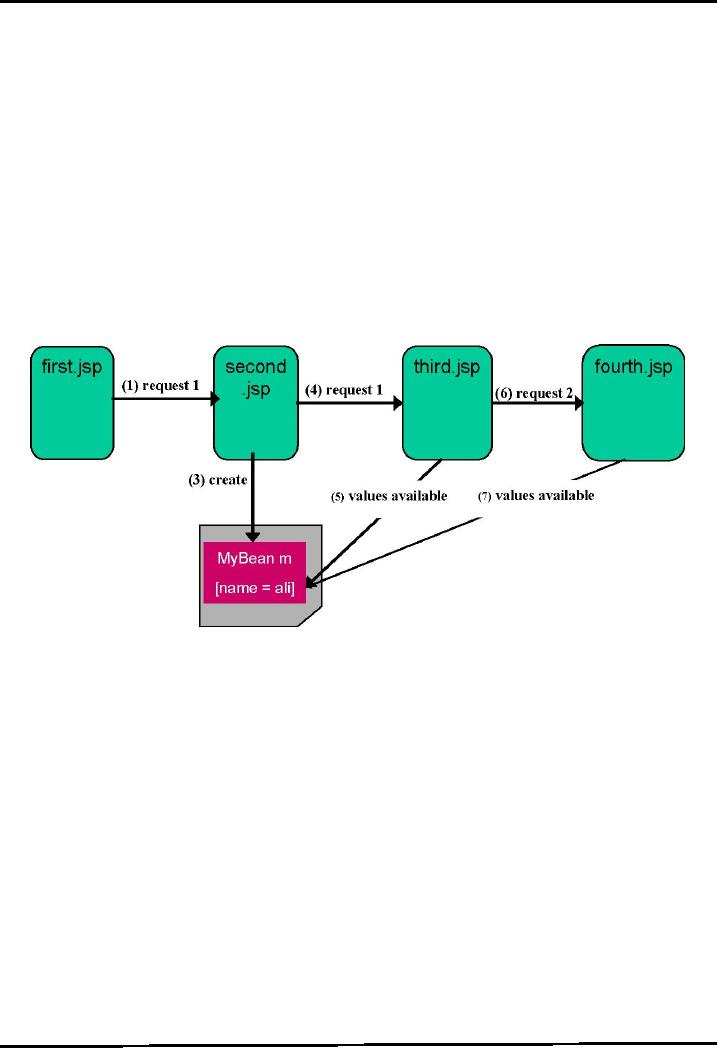
Web
Design & Development CS506
VU
in ServletRequest
object for the duration of the
current request. In other words,
until you continue to
forward
the request to another JSP/servlet, the beans values
are available. This has
been illustrated in
the
following diagram.
In the
diagram above, MyBean is
instantiated by specifying scope =
"request"that results in storing
object
in ServletRequest.
A value "ali" is also stored
in m using setter method.
second.jsp
forwards
the same request (request 1) to
third.jsp, since scope of m
(object of MyBean) is
request,
as a result third.jsp can
access the values(e.g. ali) stored in m.
According to the figure,
third.jsp
generates
a new request (request 2)
and submits it to fourth.jsp.
Since a new request is
generated therefore
values
stored in object m (e.g. ali)
are not available to
fourth.jsp.
session
This
value means that, in
addition to being bound to
local variable, the bean
object will be stored in
the
HttpSession
object associated with the
current request. As you
already know, object's value
stored in
HttpSession
persists for whole user's
session. The figure below
helps in understanding this
concept.
279
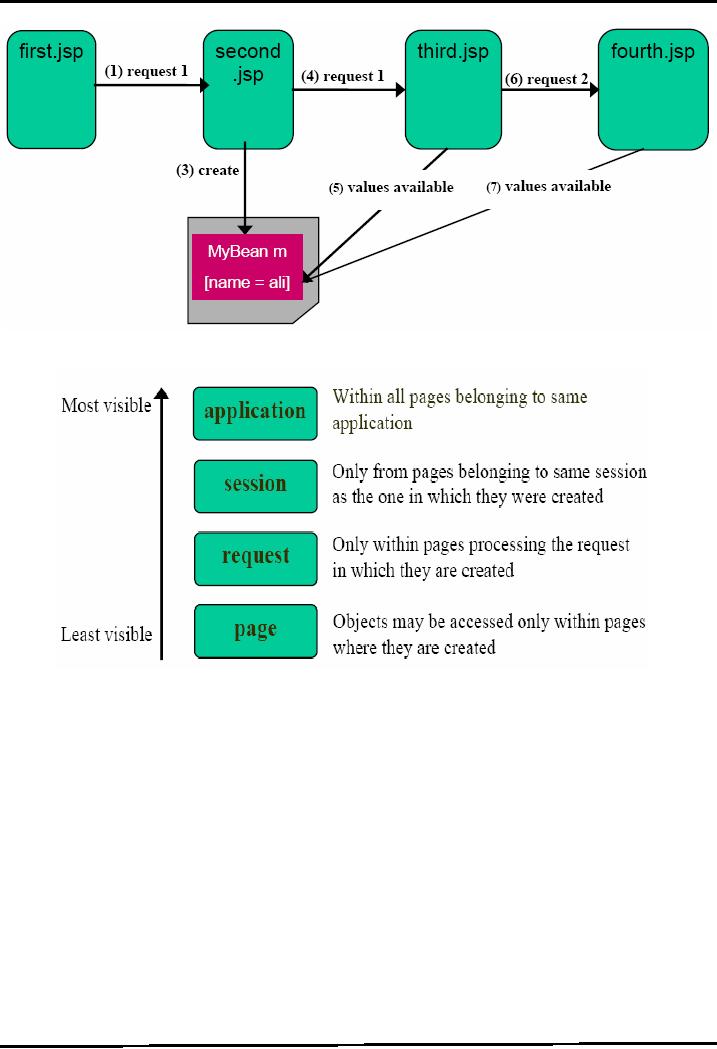
Web
Design & Development CS506
VU
ServletContext
Summary
of Object's Scopes
Let's
take another view of session,
request & page scopes in the
next figure that helps us to understand
the
under
beneath things.
280
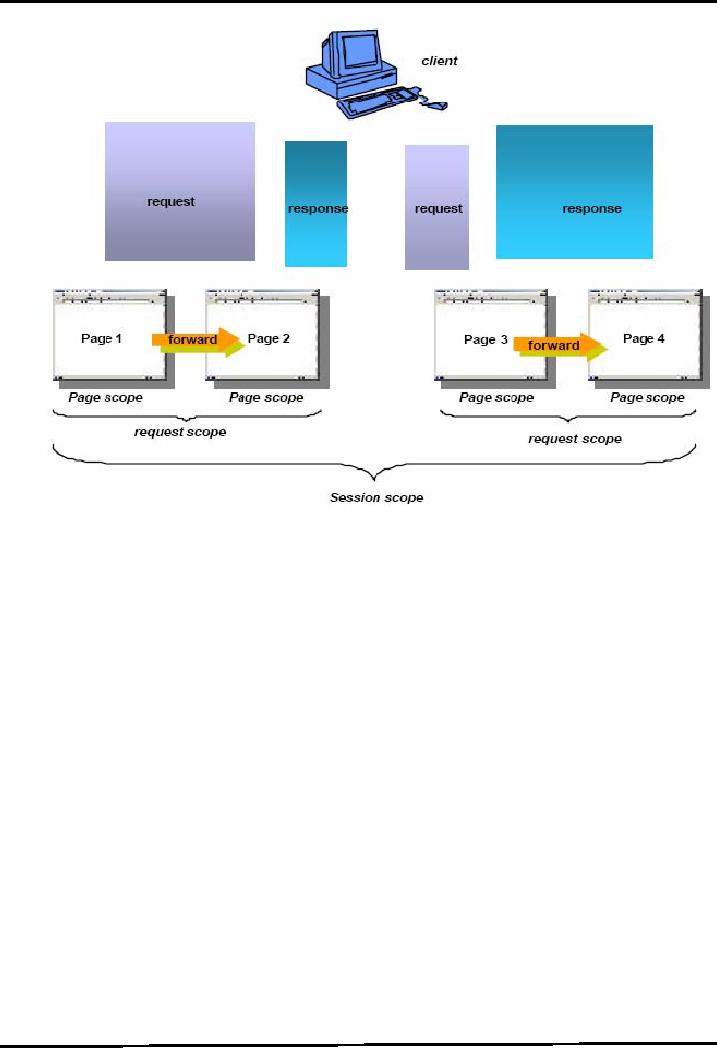
Web
Design & Development CS506
VU
The
figure shows four JavaServer
Pages. Each page has
its own page scope.
Therefore objects stored in
page
scope are only available to
same pages on which they
are created.
Suppose
page1 forwards the request to page2.
Objects stored in request scope
remains available to page1
as
well
to page 2. Similar case is
true for page 3 & page
4.
If
user makes a visit to all
these pages in one session,
object's values stored in session
scope remains
available
on all these pages.
To understand the
difference between sessions &
application scope, consider the following
figure:
281
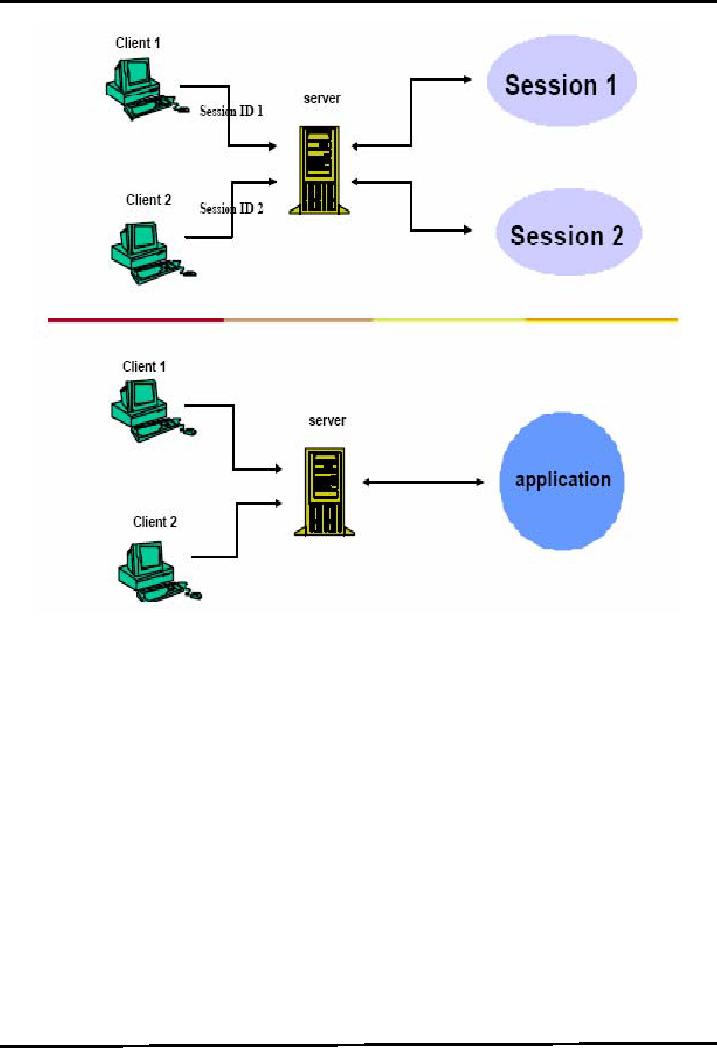
Web
Design & Development CS506
VU
As
you can conclude from the
figure, for each user
(client), objects are stored in
different sessions.
However,
in the case of application scope,
all users stores objects in
single place.
More
JSP Action
Elements
Let's
talk about two important
action elements. These are
include& forward.
JSP
include action Element
It is
used to include files at
request time. For example,
to reuse HTML, JSP or plain
text content. It's
important
to note that JSP content cannot
affect main page (in
which output is included);
only output of
included
JSP is used. It also allows
updating of the included content without
changing the main
JSP.
The
jsp:include action element requires two
attributes: page& flush. -page: a
relative URL of
the
file to be included. -flush:must have the
value "true"
<jsp:include
page = "relative URL" flush
= "true" />
jsp:include
is being equivalent to following
code of scriptlet. For
example to include the output of one.jsp
,
scriptlet
code will look
like:
<%
RequestDispatcher
rd =
request.getRequestDispatcher("one.jsp");rd.include(request,
response);
%>
Achieving
above functionality using
jsp:include action element will
look like this:
<jsp:include page =
"one.jsp"
flush = "true" />
JSP
forward action Element
It is
used to forward request to another
resource. The format of
jsp:forward action
is:
282

Web
Design & Development CS506
VU
<jsp:forward
page = "one.jsp" />
jsp:forward
is being equivalent to following
code of scriptlet. For
example to forward the request to
one.jsp
,
scriptlet code will look
like:
<%
RequestDispatcher rd =
request.getRequestDispatcher("one.jsp");
rd.forward(request,
response);
%>
References:
.
Java A Lab Course by Umair
Javed.
. Core Servlets
and JavaServer Pages by Marty
Hall
283
Table of Contents:
- JAVA FEATURES
- Java Virtual Machine & Runtime Environment
- Learning Basics of JAVA
- JAVA: Object Oriented Programming
- JAVA: Inheritance
- JAVA: Collections
- JAVA: Intro to Exceptions
- JAVA: Streams
- JAVA: Modification of Address Book Code
- JAVA: Graphical User Interfaces
- JAVA: Event Handling
- JAVA: More Examples of Handling Events
- JAVA: Problem in Last Code Example
- Java Database Connectivity
- JAVA: More on JDBC
- JAVA: Result Set
- JAVA: Meta Data
- Java Graphics
- JAVA: How to Animate
- JAVA Applets
- JAVA: Socket Programming
- JAVA: Serialization
- JAVA: Multithreading 1
- JAVA: Multithreading 2
- JAVA Web Application Development
- Java Servlets
- JAVA: Creating a Simple Web Application in Tomcat
- JAVA: Servlets Lifecycle
- JAVA: More on Servlets
- JAVA: Dispatching Requests
- JAVA: Session Tracking 1
- JAVA: Session Tracking 2
- JAVA: AddressBook Case Study Using Sevlets
- Java Server Pages 1
- JavaServer Pages 2
- Java Server Pages 3
- JAVA: JSP Action Elements and Scope
- JAVA: JSP Custom Tags
- JAVA: MVC + Case Study
- JAVA: MVC Model 2 Architecture
- JAVA: Layers and Tiers
- JAVA: Expression Language
- JAVA: JavaServer Pages Standard Tag Library (JSTL)
- JAVA: Client Side Validation & JavaServer Faces (JSF)
- JAVA: JavaServer Faces